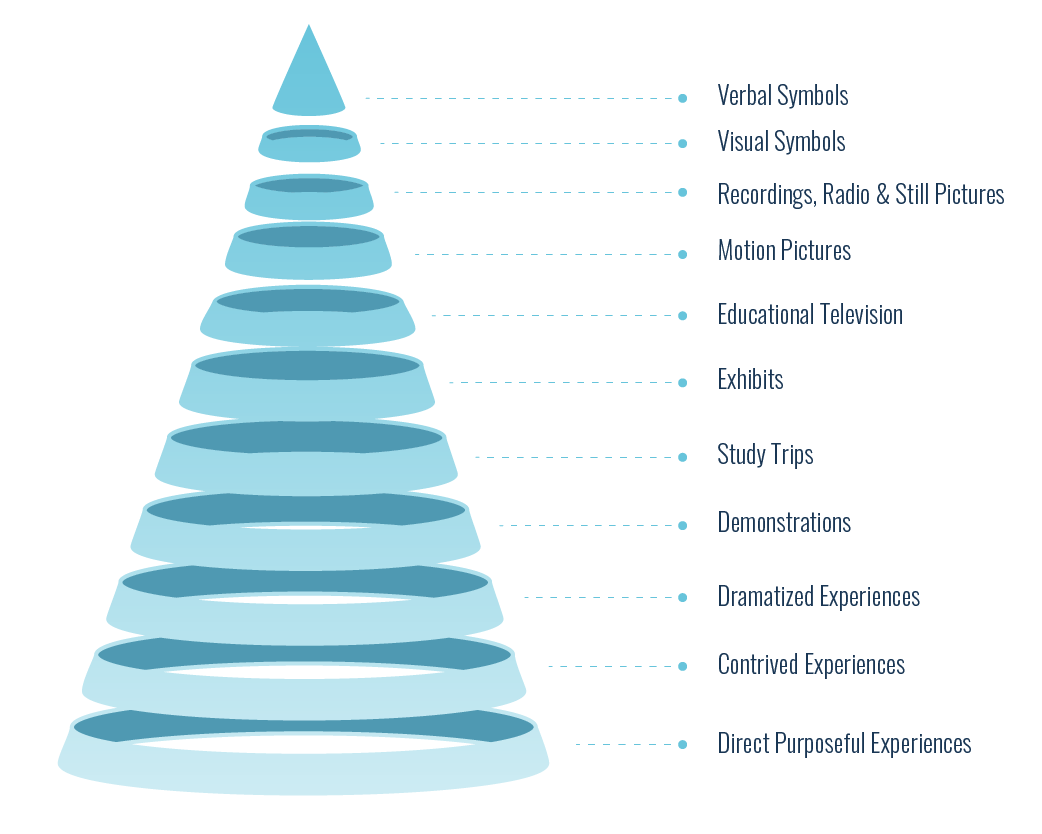Create More Effective Courses by Prioritizing Retention
We’ll be honest. We’ve been helping course creators to deliver engaging video course content for a while now, and we just discovered the Cone of Learning. Even though it’s been around for decades 🙃.
Other names given to this same concept include: the Learning Cone, the Cone of Experience (the actual original name for it), the Cone of Retention, the Pyramid of Learning, the Learning Pyramid, or the Pyramid of Retention.
Now that we do know what the Cone of Learning is, though, it’s easy to see how understanding this concept can provide a significant boost to course creators. Applying its principles can assist you in reverse-engineering the success it has generated for countless instructors over the past many years.
HINT: It’s not an actual cone that magically helps people learn things (although that would be cool).
What is The Cone of Learning?
Developed by educator Edgar Dale in 1946, the Cone of Learning is a model designed to illustrate the effectiveness of a few different popular teaching methods. It ranks these methods atop one another in order of effectiveness, with the bottom of the cone representing the most effective methods for promoting retention, and the top the least effective.

The goal of employing the Cone of Learning in educational structures is to attempt to utilize it to help boost audience retention of information. In this way, it also bolsters overall learning outcomes, including when it comes to preparing students to apply new information without as much backtracking.
One important fact to note is that, although the Cone of Learning often appears with percentages of average retention ascribed to each level in the cone, this information was added later by unknown sources. The numbers behind the percentages themselves are the subject of some debate and do not appear to have been vetted by official research. However, they can still be useful as a broad metric for planning out your content, as the principles of active learning behind the debated percentages still generally hold true under data-backed scrutiny.
The Levels of the Cone of Learning
The levels of the Cone of Learning are as follows, in order of lowest average retention to highest. We’ve included the aforementioned estimated percentages, to give you an idea of how the science might roughly measure up in practice.
1- Reading (10% retention)
2- Hearing (20% retention)
3- Seeing (30% retention)
4- Watching and Listening (50% retention)
5- Discussing (70% retention)
7- Doing (80% retention)
8- Teaching others (90% retention)
It’s important to note that your mileage may vary among the levels of the cone. The same can be said for audiences. What works for one type of course and student roster, within the Cone of Learning, may not work for another.
And the best approach for your business as a course creator will probably be a mix of the methods of instruction that make up the cone. In fact…
How to Leverage The Cone of Learning in Your Video Courses
Let’s start with the low-hanging fruit.
In looking at the cone, you can see that video course creators are starting from a good position. Watching and listening does a good job of promoting retention.
This is why video courses exist in the first place. They work.
But, as a start to our deeper dive, consider the hidden lesson even in just the middle level of the cone…
Combine Visual and Auditory Elements
While a narrated PowerPoint may not be the worst idea, consider that it offers more of a “looking and listening” experience than “watching and listening.” Incorporating live video, animations, infographics and other dynamic visuals could push your narrated course content deeper into the cone of learning. Quality needs to be there, so when considering publishing in either SD vs HD you may want to take the time and effort to publish high definition material.
Foster Community Through Discussion and Interaction
It’s a suggestion that seems to come up often, however you decide to approach your course content – interactivity increases engagement and retention. Quizzes and polls are low-lift ways to deepen learning experiences.
A more advanced and time-intensive (but often also exponentially more effective) strategy, is to offer students a virtual community where they can discuss course materials with you and one another. A popular tactic for many course creators is to create and manage an online space for current students and alumni, largely for this purpose.
Offer Hands-on Exercises and Activities
Another topic that’s come up a lot in our research is the gamification of course content. Gamification essentially “supercharges” lessons by wrapping them up in a highly-interactive format, where students must apply what they’ve learned (or muddle through applied learning) to move forward.
On a simpler level, when it comes to the Cone of Learning, consider building out small exercises that students can engage in between video course modules, to help promote increased retention through interactivity.
Empower Students to Share and Teach
Returning to the example of online groups and spaces that are attached to course offerings, consider another practice common to this arrangement. Course creators often deputize particularly successful students to share their knowledge and successes with others. This can be done formally or informally, but it helps reinforce the material you’re teaching through community-based learning. For larger course catalogs and communities, top students sometimes even go on to become teaching partners or employees of the original course creator.
It’s important to note that different types of students, on both the individual and group level, learn and retain information differently. The Cone of Learning may not be the best match for all course enrollees. Similarly, even if it does seem to work well for your students, you’ll want to mix and match your efforts. Different combinations of different levels of the cone might work better for your particular students or learners. Test some ideas and find out.
Conclusion: Utilize The Cone of Learning to Attract Success Through High-Quality Course Content
The ultimate goal for many video course creators is to build and scale a business that can help as many students as possible to learn and grow, while also providing you with a great return on your investments (in terms of both time and money). Reverse-engineering your way through the Cone of Learning can be an effective approach for accomplishing this.
A thriving course creation business should boast measurable success in promoting greater retention, not only among individual learners but in terms of ongoing course enrollment.
Leverage the vetted examples provided here today to:
– Empower students to learn collectively
– Provide applied lessons to your course content
– Foster interactivity
– Keep students engaged and actively learning
Especially when combined with other approaches we’ve discussed, such as microlearning and adaptive learning, this approach can help you craft engaging, memorable, impactful courses that resonate. Along the way, you’ll likely notice your efficacy and success as a course creator growing in lockstep with your improving course content and growing student roster.

